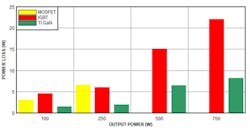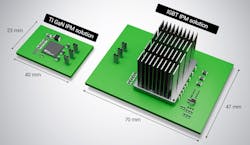Members can download this article in PDF format.
As global green initiatives catch on, designers face mounting pressure to develop maximally efficient motors and motor-control systems to meet the ratings of various energy-efficiency programs. Typically, these are seasonal energy-efficiency ratio (SEER), minimum energy performance standards (MEPS), Energy Star, and Top Runner.
Today, the most energy-eating monsters, in nearly all households, are heating, ventilation and air-conditioning (HVAC) systems, refrigerators/freezers, and dryers. HVAC alone will consume over half of the household energy budget. Following HVAC are refrigerators, which consume about 4%, and dryers, which consume about 3%. And most of the energy used by these devices comes from their motor and motor-drive circuits. So, naturally, finding ways to reduce the power demanded by these devices is a bar worth setting high.
In that vein, Texas Instruments has taken a lead in cutting-edge motor solutions. By redesigning the intelligent power module (IPM*) with gallium nitride (GaN), a slew or benefits emerge.
GaN technology simplifies design, improves reliability and efficiency, leads to a smaller device footprint, reduces power demand, and, above all, offers substantial cost savings. Collectively, the cost saving of porting motor-control circuits to GaN technology can have a dramatic effect across all areas of motor control solutions.
BJTs, MOSFETs, IGBTs
Brushless-DC (BLDC) motor (the preferred type for most appliances) technology has, for the most part, plateaued. So, extracting peak functionality is left to the power module, which is the focus of this article.
Bipolar junction transistors (BJTs) were the first technology for IPMs. These worked well, but they required complex base drive circuits to achieve the necessary on-state conduction performance.
Subsequently, MOSFETs replaced BJTs. That changed the drive circuit to voltage-based and simplified the drive circuit. However, the MOSFET’s downside was its maximum voltage. MOSFETs were limited to about 200 V before the on-state resistance became too high.
Following the MOSFET was the insulated-gate bipolar transistor (IGBT). IGBTs are a rather elegant solution since they offer the best of both BJT and MOSFET design. While these overcame most of the limitations of earlier technologies, efficiency remained a challenge because IGBT motor-inverter stage efficiency maxed out at 96% to 97%. Thus, PCB design and cooling solutions needed to consider such efficiency loss, which meant a larger package and a heatsink.
Enter GaN
A few years ago (late 2010s), GaN began to show up in semiconductors. As it turns out, GaN-based motor-control devices are capable of better performance than IGBTs or MOSFETs, have lower cost, and are more energy efficient (Fig. 1). As a result, GaN is becoming the go-to technology for motor control.
To that end, TI developed the DRV7308 three-phase GaN IPM.
Drilling Down into the DRV7308 IPM
The DRV7308 is a three-layer-metal, e-mode, GaN technology-based IPM. One notable benefit of GaN-on-silicon technology is significantly downsizing the package and components. This results in realizing up to a 50% gain in power savings.
In addition, the reduced power consumption makes it possible to forgo using the heatsink that’s needed with MOSFETs and IGBTs when driving a load under 250 W. At loads up to 650 W, the maximum rated load of the DRV7308, a heatsink will still be needed. However, the IPM power efficiency of >99% is retained up to its rated power.
GaN Advantages
Integrating GaN and silicon creates a platform with extremely attractive properties. A gallium-nitride chip offers better switching performance without causing voltage overshoots and oscillations at the phase node. This translates to lower EMI.
On the audible side, GaN-based devices reduce the noise caused by torque ripple. In earlier devices, the dead time occurs at every p/3 radians. That equates to a minimum of 1- to 2-ms dead time. With GaN, that drops to as low as 200 ns, a reduction of 80% or greater. This, in turn, lowers current distortion and audible noise.
Dead time is one of the most critical parameters of motor control. For variable-speed applications, the lower the dead time, the better the pulse-width-modulation (PWM) parameter. Because the DRV7308 offers an adaptive dead-time feature, the PWM duty cycle is enhanced, improving the overall speed range settings.
This is a significant advance in design because faster response to changes in load helps to optimize the overall efficiency of the system. Dead time affects other parameters as well, such as the accuracy of control, current distortion, and total harmonic distortion, which also affect efficiency.
Another significant advantage of GaN over IGBTs is power. Gallium arsenide (GaAs) can realize a 2X reduction in power losses. GaAs has lower output capacitance and low drain-to-source on-resistance (≤205 mΩ). Also, there’s no reverse recovery loss and no tail current. This translates into the ability to use higher slew rates, which enables better high-frequency response, wider bandwidth, and reduced distortion.
Adding all of this up results in a significant reduction in device footprint (Fig. 2). Therefore, GaN-based motor-control systems are particularly applicable, especially to household products requiring 250 W or less—where size and efficiency are a priority.
Conclusion
Energy efficiency is no longer an option. Nor is it a nice-to-have, or differentiator, among products. The differentiator is how well it’s implemented in the design from inception to general availability. Today, every watt—often even milliwatt—saved matters, making GaN-based motor control as the go-to solution.
*An intelligent power module is called such because it integrates advanced features to make it as functional, efficient, and reliable—hence “intelligent”—as possible. Such features include increased manufacturability, lower cost, reduced size, improved reliability, simplified implementation, circuit protection, and cost reduction.


